
Updated 8/6/2015
June 5, 1969 Delta Company
With Later Support from Charlie Co.
![]()
RED
WARRIOR MISSION
STATEMENT
“To close with the enemy by means of fire
and maneuver in order to destroy or capture him,
or to repel his assault by fire, close combat and counterattack.”
The Battle at (ZA 148768) Map Sheet 6537-II
Delta Co., 1st Battalion, 12th Infantry Regiment, 4th Infantry Division
Republic of Vietnam
Written by Larry Boyd
Additional contributions by Del Bibles, Butch Cooper, Mike Cresap, Wayne Inman, Jim Daniels, Mike Gowan, Roger Hill,
WEBMASTER NOTE: TO PRINT THIS REPORT - 28 pages CLICK HERE (PDF FORMAT)
1LT Larry Boyd Company Commander |
In response to several requests to write about the battle on June 5th 1969 between Delta Company 1/12th and what was reported to be the 24th NVA Regt. (Regiment). I am responding with the following account to the best of my recollections along with some records research and input from some of my fellow soldiers. In order to more fully understand that battle, I think that it would be helpful to first recount the overall operation and enemy contact leading up to the June 5th battle. Larry Boyd – September 2011
|
1/12th SOP (Standard Operating Proceedures)- Background Conditions
The 1st Battalion, 12th Infantry Regiment, (Red Warriors) 4th Infantry Division, area of operation was in II Corps located in the Central Highlands. The Base Camp was located at Camp Enari just outside of the city of Pleiku. The Central highlands contained several major infiltration routes for the NVA.
The Red Warriors operated mostly in the areas of Dak To, Kontum, Polei Kleng, and to the West of these areas toward the Cambodian Border. They had also operated further South around Ban Me Thuot and Duc Lap (also close to the Cambodian Border), as well as many other places without names.
The Red Warriors were an unusual unit. The primary method of operation was to act as a reaction force to where ever additional forces were needed. In other words, the Battalion was sent to where the action was. The 1/12th was considered “light Infantry” but also were “air mobile.” Many times one of the Companies would be assigned to “operational control” to another Battalion that needed reinforcements. The 1/12th conducted so many Combat Air Assaults that many men were awarded Air Medals.
While it was common practice to work with other units, most of the time the Battalion, Company and Platoon's were conducting our own search and destroy missions, recon patrols, and ambush patrols. Recon patrols, Short Range Recon Patrols (SRRP’s), usually went 3 to 5 hundred meters out from the Company Patrol Base, and were conducted by a four man team. Recon patrols typically lasted 3 or 4 days and nights. If detected by the enemy, there was no easy way to get help to them. To say the least, these were very scary missions.
Most Infantry units in Vietnam operated out of a base camp or a semi-permanent, large reinforced Firebase that normally had an airstrip for fixed wing aircraft resupply. These units would leave their base camp on missions in search of the enemy. Operations normally would last from a few days to several weeks. They would then return to their base camp for several days or weeks of rest before going out on another mission. These base camps had hot chow, showers, clean clothes, cots to sleep on, and in most cases Officer and NCO clubs with cold beer.
This was not the case for the Red Warriors. We lived in the bush 24/7. Line companies slept on the ground, covered by a makeshift tent out of ponchos, ate C rations, and on very rare occasions we would get cooked food (usually cold or lukewarm at best) sent out in mermite (insulated) containers. During the rainy season everybody and everything one carried stayed wet for 3 plus months. The only reason a soldier would return to Base Camp was for medical treatment or processing for R&R or end of tour.
Firebases were highly mobile and relocated to where ever units were sent. The Company Patrol Bases moved frequently! Much of the time they moved every day. "Humping" the bush with about 90 pounds on your back while searching for the enemy was the norm.
It was not uncommon to get a resupply of C rations by them being kicked out of a hovering helicopter because there was no place for the chopper to land. Most water resupply was gained by finding a stream or spring. It was common practice that patrols were sent out to find water. At one point, men went for over 2 months wearing the same fatigues because we couldn't get resupplied. Three to four weeks was the average for a clean change of uniform. Choppers delivering C rations and ammo took priority over clean clothes and mail.
The sole purpose and mission was “To close with the enemy by means of fire and maneuver in order to destroy or capture him, or to repel his assault by fire, close combat and counterattack. Every company in the Battalion was involved in many firefights and some very large battles.
Living conditions were tough, but so were the men of the 1/12th!
PRELUDE
MAY 23rd and MAY 24th
The Battalion moved from up in the high, triple canopy, mountainous jungle terrain around Fire Base LZ Mile High west of Kontum down to Fire Base LZ Nicole south/southwest of Kontum as part of “Operation Putnam Tiger’’. The terrain in this area was still jungle, but was more open with rolling hills. The move was made in response to intel reports of heavy enemy activity in that area. (See LZ Mile High - MapSheet 6537-IV)
Delta Company provided Fire Base Security while Alpha, Bravo, and Charlie Companies moved out and began search and destroy missions.
MAY 27th
At approximately 1130 hrs. on May 27th Charlie Co. initiated contact with what was at first thought to be 7 NVA soldiers at location ZA125767. That contact progressed into a battle with a much larger unit. Later identification indicated that it was a reinforced Company sized unit of the K6th Bn. 24th NVA Regt. During this battle Capt. Wandke (Charlie Co. Commander) was wounded several times. LT. Orndoff (Bn. S3 Air) was CA’ed (Combat Assaulted) in and took over as Charlie Company Commander during the ongoing firefight. Records indicate that Charlie Co. sustained 8 KIA’s (Killed in Action) and 37 WIA’s (Wounded in Action). Additionally Lt. Col. Carter (Bn. Commander) and Specialist Ken Seward (senior Bn. Medic) both from Headquarters Company (HHC) were also killed. In all, 9 men die in the battle. Enemy KIA’s were reported as 40.
MAY 28th
The next morning Delta Co. CA’ed into Charlie Company’s location. Our mission was to secure the LZ while the extraction of Charlie Co. was completed, then we were to get on line and sweep the contact area.
We were all extremely apprehensive about this combat assault. We knew what Charlie Co. had gone thru the day before and we were acutely aware that we were headed into a very dangerous area. My group was to board the 1st chopper of the 2nd sortie of a flight of 3 choppers. We had to pull several bodies off of the chopper before we could load up, two of which were Lt. Col. Carter and Specialist Seward. The floor of the chopper was covered in blood. The blood along with the lingering smell of death was unnerving. It was a short flight to our insertion point, but certainly long enough to raise our apprehension to the highest level.
After the remainder of Delta Co. was inserted and the extraction of Charlie Co. was complete, we got on line and swept the contact area. Lt Orndoff of Charlie Company had remained behind with Delta in order to provide a lay-of-the-land of the battle site, and helped conduct the sweep. We immediately encountered a very large NVA bunker complex. As we moved thru the complex, we threw hand grenades and fired into many of the bunkers to insure the complex was clear. We found enemy bodies, a lot of blood trails and drag marks. We encountered sporadic light contact with the NVA resulting in (to the best of my memory) 2 or 3 NVA KIA’s and no casualties of our own.
The next 3 days we continued our search and destroy mission moving slightly north, then west and then southwest.
MAY 31st.
On May 31st we had just stopped to set up a patrol base as a blocking position at approximately ZA 112753 when Bravo Co. initiated contact with the NVA at ZA 097761. The NVA were in another well built bunker complex (the NVA unit was later identified again as elements of the K6th Bn. 24th NVA Regt.). Major Owens, the Bn. S-3 was severely wounded as he was firing at the enemy from a LOH while flying overhead of Bravo’s area of contact. In this battle Bravo Company sustained 8 KIA’s, plus 1 KIA (medic) from HHC. They had 21 WIA’s (including their Company Commander Capt. Patrick). NVA KIA’s were reported as 68.
As the enemy withdrew from contact with Bravo Co. they ran into our blocking position at ZA112753. We had just sent out a 4 man short-range recon patrols to the south, east, west and north. The 4 man patrol to the south encountered several NVA soldiers moving in an easterly direction. They engaged the enemy and were subsequently pinned down. Third Platoon quickly moved out to reinforce their patrol and joined the firefight. The 4 man patrol to our west reported movement all around them. Too many to engage. About this time the NVA stumbled upon the southwest side of our Company perimeter. We had 3 different contacts, at 3 different locations, all at the same time.
We killed several at the edge of our perimeter. One just as he raised up to fire his 2nd B-40 rocket at us. 3rd Plt. fought off the NVA to the south and started back to our perimeter bringing their 4 man patrol with them. The patrol to the west was able to escape and evade the enemy by moving to their northwest. They moved in this direction to allow us enough room for a set of Charlie model gun ships to make a north south run on the west side of our perimeter. The gun ships fired their mini guns so close to us the rounds kicked dirt in our guys faces. That patrol as well as the ones to our east and to our north, were able to return to our perimeter later that day. The records show that we had 3 WIA”s, one seriously that required a dustoff, and , two that didn't. NVA KIA’s were 10.
JUNE 1st.
We moved east in pursuit of the enemy on June1st. The next day we stopped, set up a patrol base, got supplies, mail, and got paid and rested. We remained in this location for a couple of days, sent out recon patrols, back hauled one of the wounded, received additional orders, and returned to pursuing the enemy on the search and destroy mission.
RADIO LOGS - You may be interested to follow daily events leading up to the battle. Download PDF Radio Logs from May 27 - June 4, 1969. When reading these logs, the following unit designations apply: Note that unit designations changed on June 1.
MAY Logs |
A Company = 96 |
B Company = 39 |
C Company = 18 |
D Company = 20 |
Recon = 92 |
Battalion = 60 |
JUNE Logs |
A Company = 13 |
B Company = 39 |
C Company = 67
|
D Company = 43 |
Recon = 90 |
Battalion = 63 |
81 = LTC Carter - KIA May 27 |
35 = BN S-3 Maj Owens (May) |
|||||
May 27 |
May 28 |
May 30 |
May 31 |
June 1 |
June 2 |
June 3 |
June 4 |
June 5 & 6 |
Thanks to Sgt Del Bibles for sharing the May - June 4 radio logs, and to SSG Roger Hill for providing the June 5 & 6 Logs
RADIO LOG DISCREPANCIES
Before continuing, I would like to explain that the radio logs that I will begin to refer to were recorded and maintained by radio operators located at the Battalion Tactical Operations Center (TOC) located at Firebase LZ Nicole. These records were never exact or completely accurate, especially during actual combat operations. There are just too many radios blaring , too many people talking and just too much going on all at the same time for one person to completely and accurately record all of the activity and communications. At times, the logs would be completed hours after the actual events. With this in mind, and to the best of my and several fellow soldiers memories, I took time to correct some of the inaccurate reports contained in the radio logs.
BATTALION BATTLE AREAS FROM MAY 27 - JUNE 5
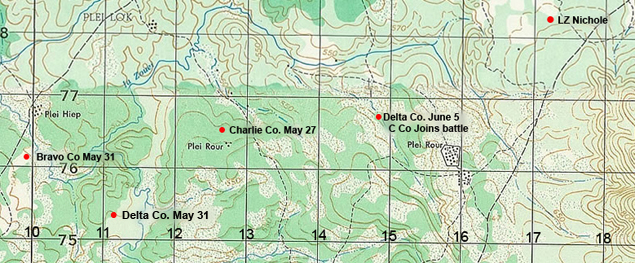
To view entire map sheet - Click for Map Sheet 6537-II (note: LZ Nichole is on Map Sheet 6537-I )
LZ MIle High Map Sheet 6537-IV
RADIO LOGS
Download the entire Radio Logs for June 5 & 6 HERE. Viewable as PDF, and printable.
Radio log Identifications:
| Gambler 6, 26 and 56 | Charlie model helicopter gun ships |
| Cider 22 and 23 | Forward Air Controllers (FAC) flying a small one man fixed wing spotter aircraft |
| Spades and Sky Raiders | A1E Sky Raiders--WWll era fixed wing prop driven fighter/bomber aircraft |
| Buck 9 | Cobra model helicopter gun ships |
| Headhunter | Cobra model helicopter gun ships (If I remember correctly) |
| Crock 7 | Charlie model Huey helicopter gun ships |
| Scorpion 22 | Cobra model helicopter gun ships |
| Hornet 11 | F-4 Phantom jets |
| Gladiator 20 | Huey model helicopter (slick) (armed with 2 M-60 machine guns) normally used for transportation, re-supply and dust offs (Med evacs). |
| Bikini 15 and 25 | Huey model helicopters (slicks) |
| Black Jack | Huey model helicopter (slick) |
JUNE 5th
On June 5th we were moving east/northeast with 2nd Platoon on point, 3rdt Platoon. next, with1st Platoon pulling drag and rear security.
*Radio Log Entries are Bordered in Blue
| 0710 | Delta Co. has SP’ed (departed) their last night’s N/L at ZA132763) |
| 0735 | Delta Co. has discovered an enemy bunker complex. Will secure it and move in and tear up a little bit |
| 0810** | Log reports that we blew some bunkers and found some papers that we will back haul when possible |
**This is incorrect.
Neither I, nor several other Delta soldiers I discussed this with, remember blowing up any of the bunkers that we had discovered. The radio logs show that we found bunkers at 0735 and left at 0810. Certainly not enough time to clear, then blow up bunkers. Besides that, because of the area we were in, we would have never exposed our position by blowing abandoned bunkers.`
We continued our pursuit of the enemy. We would move for 200 to 400 meters, stop and send out patrols in a cloverleaf fashion to our flanks in search of any signs of the enemy. This also helped to establish a more enhanced secure method of movement. We would then continue our direction of pursuit.
| 0925 | Patrol location is ZA 143760 |
| 0926 | Bypass the village to the north |
There was a village (Plei Rour) in the path of our route of march. As per instructions we changed direction to north/northwest to bypass the village.
We continued on our north/northwest directional course. The terrain in this area was rolling hills and the vegetation was not as thick as we normally operated in. This allowed us to have a point element (instead of just 1 point man) and we also had flank security for each platoon as well as a rear security element. This terrain allowed us to move slow and quite. We were well aware that we were in a highly dangerous area and had been for over 2 weeks. Every line company had been in firefights and had received multiple causalities. Especially Charlie (May 27th.) and Bravo Companies (May 31st.) Delta Co. had been in firefights on May 28th and May 31st and we were now on the trail and in pursuit of the same enemy unit.
We came to an open area, halted and sent about a squad sized element of 2nd Plt. across the open area to recon and make sure it was clear before moving the remainder of the Company across. The recon element reported all clear so we started across the open area with the rest of the Company.
The remainder of the 2nd Plt., with the rest of the Company behind them, was almost across the open area when the point team reported spotting one individual dressed in dark clothing moving (not running) to the east. They only caught a quick glimpse and couldn't tell if it was enemy or not. Could be a civilian since we were close to a village.
| 1010* | Just spotted an individual who ran away. We fire a few rounds at him and will be moving up to check out the area |
*This is incorrect.
We reported the sighting. The point element did not fire at this individual mainly because they didn't have time and they had also only caught a quick glimpse of him and could not positively identify whether he was a villager or the enemy.
We requested a LOH (light observation helicopter) for an aerial recon before advancing any further. Bn. advised that a LOH was not available and instructed us to move forward and investigate. As instructed, the Squad sized point element moved forward to investigate and recon the area while the rest of the Company remained in place.
| 1025* | Spotted 3 more individuals with some type of uniform (Green) and head gear. They fled to the east - they employed S/A (small arms) - Request a LOH to check it out. Have not received any fire at this time. ZA 148768 |
*This is incorrect
We had previously requested the LOH on our 1010 radio transmission.
Our point element did spot and surprise 3 uniformed NVA soldiers sitting in a group next to a bunker, just across a ravine, about 25 meters to their front. The point element opened up on them and killed them instantly. They didn’t even have time to move much less return fire.
We were moving with such stealth that they had not detected that we had entered the edge of their bunker complex.
We, of course, were not yet aware of that fact either.
The men of Delta Company had a lot of combat experience. The Company had been in many previous firefights and had an abundance of highly skilled, battle hardened, soldiers. This was the beginning of the most ferocious and lengthy battle against the largest force that any of us had ever fought.
During the next few minutes the enemy began reacting and returning fire. The return fire was minimal at first, then continued to increase in intensity as the enemy reacted to our attack.
PFC Wayne Inman, 1st Squad, 2nd Platoon M-60 gunner recalls the earliest moments of the battle.
PFC Wayne Inman |
When the fire fight initially started, I set up my machine gun where I was told too. Several other guys were positioned to my right and somewhat behind me and others to my left. Things were so close that I could see NVA bunkers just a spitting distance of where I was laying. The NVA began returning fire with automatic weapons. Then, the man directly behind me got hit almost immediately. He was dead. I began returning fire non-stop. Suddenly a B-40 rocket exploded behind me and I heard someone yell "Oh my God, no!" All this time I kept firing yet remember yelling for someone to help me feed the ammo. I was having one hell of a time holding up the barrel to keep it on target, and the ammo belt kept getting hung up on the vines and weeds around me. It sticks in my mind that there was this small tree about four foot tall, just a naked bush really, that was just three or four feet in front of me. |
Four or five enemy bullets hit the trunk of that little tree, chipping away at it, blowing splinters in my face. I realized they were definitely aiming at me! Then, at least two hand grenades were thrown at me. They didn't have much of a punch, but they did blow dirt into my face and eyes. When I wiped the dirt away, I remember looking at the soil in my hand and thinking how rich looking it was and thinking of the good crops that one could grow in that earth. One hell of a thing to be thinking about while someone was trying to kill you. The NVA were up hill just a bit, and across a steep ravine. I was forced to hold the gun up with my arms and I got burned pretty badly. Even today I can't forget the smell of my arms burning. PFC Wayne Inman, 2nd Plt, 1st Squad |
|
Within these first few minutes we had 2 men wounded and 1 killed by small arms fire. The point element was unable to maneuver or withdraw because they were right on top of the enemy and were heavily involved in a fire fight and would not leave the 3 causalities.
The remainder of the Company quickly moved across the rest of the open area and immediately joined in the battle. We hooked up with them and integrated them into a hastily formed perimeter and escalated the fire fight. We did, at this time, spot several NVA moving in front of us toward the ravine and opened up on them. (Maybe this is what the log is reporting. No way to be sure). I assume that they were trying to move closer to their bunkers for cover. Regardless, they didn’t make it.
It’s impossible to describe just how intense the battle had now become. We were receiving and returning an incredible volume of small arms fire and also receiving incoming B-40 rocket fire. The sound of the battle was intense beyond description. We immediately requested artillery and gun ships.
| 1103* | Have called intermission to large organics at this time. Will be sending down my 57 element to check out the ravine further. |
*This is incorrect.
No mortars or artillery had been fired at this point and the entire Company had already been at the ravine and enemy bunkers and engaged in heavy battle for about 30 minutes.
| 1110 | D Co receiving AK fire at this time. Requesting gun ships. Employing Red Leg ZA 148768 area of contact |
| 1113 | Neg guns ships available (Bn. advises that there are no gun ships available) |
Clarification
1110 Radio log reports that we are receiving AK47 fire (this had been reported earlier at the beginning of the firefight) and requested gun ships (this was an additional request for gun ships) and that they were employing red leg (artillery) at ZA148768 area of contact.
There appears to be a major time line discrepancy here, because earlier in the log it’s reported at 1005 that gun ships are cranking up at Camp Hollaway. I have no explanation for this discrepancy. I do know that we didn’t get any gun ships at this point. It’s probable that the gun ships had been diverted to another unit.
| 1114 | Receiving fire from all around |
Clarification
This was actually a report that we were receiving fire from several different directions. We never received fire from all directions anytime during the firefight.
NOTE: During previous engagements between the 24th NVA Regt. and units from the 1st /12th, the NVA would fight for a while, but then would begin withdrawing from the battle. This day was different. They stayed and continued to fight. We later learned that they were spread out in several bunker complexes over about a 500 meter area. But they had a large open area to their east and then further east was highway 14, a village was about 1 kilometer to their south, a large open area to their north, LZ Nicole was about 2 to 3 kilometers to their north/northeast and Delta Co. was at the edge of their bunker complex on their west. Their daylight avenues of escape were blocked. They were pretty much boxed in.
Delta company was at the edge of their bunker complex on our east and by now we were receiving an extremely high volume of fire from our east, southeast and south. We had open areas to our west and north. So we were also somewhat boxed in.
Over two clicks away the troops at LZ Nichole could hear the battle.
Sgt Jim Daniels |
We were asked to help unload a big Shit Hook that had just landed. We all went out to unload ammo, C’s, and other supplies, and once empty the noisy bird lifted off raising a messy red cloud of dust as it rose into the blue cloudless sky. As the noise of the chopper faded away, it was replaced with the sounds of distant shooting. Heavy shooting. I heard someone say, “Someone’s in shit.” Within minutes the Platoon Leaders were all called to the C.P. It was an eerie feeling because you could actually sense in the air that something urgent was happening. People were just standing, staring in the direction of the sound of the far away battle. Sgt Jim Daniels, 2nd Platoon C Company |
The only thing that either unit could do at this point was to hunker down and fight, and fight we did.
Their advantage was that they had us vastly outnumbered, had bunkers for protection and reinforcements scattered out around the 500 meter area of their bunker complex.
Our advantage was the experience, tenacity and indescribable bravery of our men along with our ability to accurately concentrate an extremely heavy volume of small arms fire on the enemy. We also were able to quickly adjust our firepower to repel their attacks, maneuvers and attempts to penetrate our perimeter and withstand their attempts to out flank us. Our superior firepower also included our artillery units, helicopter gun ships, F4 Phantom jets and A1E Sky Raiders (WWII era single engine prop driven aircraft. They flew low and slow and could put their firepower in danger close). Air support was to become a critical element in this battle.
| 1117 | Reported incoming |
This is when we began receiving 82 millimeter mortar fire. This is also when the battle escalated to what can only be described as horrific. The fighting had already been unbelievably ferocious . The worst part was that because of the enormous volume of fire there was no time to dig foxholes to get into for at least some protection from the mortars. All we could do was hold our positions, continue firing, and hope and pray that we didn’t get hit by a mortar round.
PFC Inman remembers the mortar fire .
PFC Wayne Inman |
Soon I was running low of ammo, so I started calling for more. One of the men got a belt and yelled for my attention so he could throw it over to me. I looked over my shoulder toward him, that’s when I saw another one of our men lying motionless. I figured that he must have been hit by a mortar round, or perhaps a B-40 rocket. I did get the ammo, and another man crawled to my position to help feed the belts into my machine gun. By now my arms were both burned pretty badly. Soon, several different guys were throwing ammo over to us to keep us from running out. At some point the guy feeding ammo to me wanted to switch so I could give my arms a break. I had fired so much ammo that the brass had piled so high that the gun would not eject the shell casing over it. I had to reach over and move the brass out of the way. I was using my burned arms to do this. |
We were just getting ready to switch positions when we heard a mortar tube pop. I yelled to take cover! The mortar round exploded right behind us, and when I looked up I saw that he was seriously wounded in the forehead. I got out a bandage and put it on his head, but he was also hit badly in the arm, just below the shoulder. I told him that we both would have to go and get him bandaged up. (At the time I didn't want to use mine because I was sure I would need it before the fight was over.) He got ready to head back up the hill while I sprayed the M-60 up and down the ridge line. Then another man called out to me that he had been hit. He wanted me to come help him. I assured him that I would, just as soon as I got the assistant gunner and the machine gun to safety. I didn’t want to leave the gun, fearful that the enemy could get it. So I grabbed both the wounded grunt and my 60 and began moving up the hill. A short distance later we ran into another one of our guys. I asked him to give me covering fire while I went back to help the other wounded guy. But as I started out, he called me back and said that if I would cover for him, he would go and get the wounded man. I gave covering fire as he moved out, but suddenly turned my attention to another NVA firing at us. I took him out with the M-60. PFC Wayne Inman, 2nd Plt, 1st Squad |
|
Just a short distance away from Inman, SP4 Mike Cresap, 1st squad, 2nd Platoon, also recalls these early stages of the fight
SP4 Mike Cresap |
At one point, the tremendous roar of firepower was so loud that it stuns and numbs you to the point one can hardly physically react or mentally think. You just want to crawl under your steel pot. A mortar round landed within our squad area causing multiple KIA and WIA. A defining life’s moment for me happened when although wounded, but not as seriously as others, I saw movement to my front and realized no one around me was firing, probably because they were all casualties. I picked up my M-16, but it was inoperable because of shrapnel damage. Same for the M-60 next to me. I had finally mustered up enough courage to fight for my life and I had no weapon to fight with. I threw two grenades to my front, not classic style, but hard low line drives thrown from the prone position to a specific area because I worried about one hitting a tree and bouncing back and blowing myself up. |
I then picked-up a KIA’s M-16 and proceeded to fire on full automatic in a Z formation repeatedly. The M-16 got hot, so I picked up another M-16 and fired the same Z formation on semi-automatic. I could not hear or see anyone on my left or right firing. Then, to my left I heard and then saw a M-60 machine gunner going to work. A real morale booster for me. Degrees of firing went on all day. Mike Cresap, 2nd Plt |
|
| 1124 | Report everything quieting down. Have about 3 wounded will get further info on it | 1130 | Reports B-40 incoming - request dust off placed on standby |
Clarification
1124 We report everything quieting down. Have about 3 wounded will get further.
This would have been 3 additional wounded. This was a very short lull in the battle.
1130 (late entry) Requested a dust off to be placed on stand-by.
I think that this is when the NVA started reorganizing and started attempting a flanking maneuver to our south and southeast, trying to work their way around to the west side of our perimeter.
First Squad Leader Del Bibles, of the First platoon, remembers the NVA probes and taking care of the wounded.
|
During the firefight, my world was with 1-1 and keeping contact/support to the 2 squads on either side of us. We were probed many times; it appeared that the NVA were trying to flank us, looking for a weakness. At different times in the firefight, there were short lulls, followed by intense fire, to incoming, to sniper fire. As the firefight progressed, I re-positioned my squad into 2 man teams to more adequately protect our flank, each other, and tie in with squads on either side of us. This was to make sure that our rear perimeter was secure with interlocking fire. Earl Albertson (1-3) was also re-positioning his squad. |
Walter Runningcrane, our 60s gunner, was wounded and later when time and circumstances allowed, everyone in the squad (and others) at one time or another, spent the night looking after him, talking to him, making sure that he didn't go into shock. He was finally medivaced out the next day. Sgt. Del Bibles, 1st Plt, 1st Squad |
|
About this time is when we started receiving incoming mortar rounds again and the amount of incoming rounds greatly increased along with the small arms and B-40 rockets. Things got even worse. An increasing number of our men were getting wounded by the mortar rounds. Not only were we fighting the enemy to our front, but now we were having to adjust our positions to combat their maneuvers while under heavy fire and we were now starting to get fire from snipers in the trees. There were screams of “O my God” and calls for “Mamma’’. All of our medics were either wounded or killed. Both of my RTO’s (radio/telephone operators) were seriously wounded. All of the Platoon leaders were wounded.
Things were getting desperate, but the worse things got the harder the men fought.
| 1131 | BN CMDR Reports possible hit, will be coming in to check out the LOH |
Clarification
1131 Radio log report that the LOH that Lt. Col Fiora (the new Bn. Commander) is in has possibly been hit by small arms. Will be coming in to check out the LOH. No log of when the LOH came on station.
EXPLAINATION - Artillery, gun ships and air strikes coordinatIon
For the sake of a clearer understanding to a civilian or non combatant that is reading this account, I think that it would be helpful to explain how artillery, gun ships and air strikes are coordinated during battle.
The coordination of the firing of artillery for an Infantry Company is conducted by an Artillery FO (Forward Observer) that is assigned and travels on the ground with the Infantry Company. The Company Commander informs the FO where and what type rounds he needs fired. The FO coordinates and adjusts the fire mission with the artillery Battery. The FO also coordinates with the battery and any air assets to insure there is a check fire (cease fire) while air strikes and gun runs are being conducted.
When any air support arrives on station they check in with the Battalion Tactical Operations Center (TOC). The TOC then turns the air assets over to the Company Commander.
If the air assets are jets, A1E Sky Raiders or other fixed wing aircraft, their strikes are coordinated by a Forward Air Controller (FAC). This is normally 1 pilot flying a fixed wing prop driven light aircraft equipped with rockets to mark the locations of the requested air strikes. The FAC coordinates with the Company Commander as to required strike location as well as the location of our men on the ground, location of the enemy, direction of the run, and subsequently what adjustments in strike locations are needed. The Company Commander talks to the FAC. He does not talk directly to the aircraft carrying out the strike. The FAC talks to the strike aircraft.
If the air assets are helicopter gun ships, Med Evacs, dust off’s or re-supply helicopters, then the pilots talk directly to the Company Commander to obtain and coordinate the information and requirements described above.
| 1132 | Gambler 26 on station |
We finally get air support from a set of Charlie model Huey gun ships. They also fly low and slow and can put rockets and mini guns in danger close.
Radio Log Entry
| 1200 | Employing gun ships to the west and red leg (artillery) to our east. Gun ships are taking ground to air fire from the NVA. Receiving most of the fire from the west. |
| 1205 | Gambler guns expended buck 9 on station to expend (Editor Note: Buck 9 is a set of Cobra gun ships. Faster with more firepower than the Charlie model gun ships.) |
| 1208 | Head hunter leaving for other mission |
This is a different set of Cobras not mentioned before. They were obviously also on station, but I don’t remember if they actually made any gun runs before they were diverted or not.
By now, we’re running extremely low on ammo. Even though we were continually redistributing ammo, some of the men were completely out and were reduced to throwing hand grenades. Radio logs don’t record this, but about this time we do start getting re-supplied with ammo. Choppers are flying by at about 80 to 90 knots and kicking out boxes of ammo. They couldn’t land because of the heavy volume of fire. Much of the ammo lands closer to the NVA than it does to us, but at least, we got additional ammo. They made enough runs like this that they were able to keep us from completely running out.
| 1220 | Second set (actually the third set of gun ships) Buck 9 have expended. Employing back to red leg at this time |
| 1219 | Cider 23 on station. |
Forward Air Controller is on station and standing by.
Logs don’t report this, but the FAC immediately marked targets and directed a set of F4 Phantoms to targets on the west and southwest side of our perimeter.
| 1230 | Reports tube popping on a 70 degree azimuth 400 meters out. Don’t know if it’s B-40 or incoming (mortars). |
We finally got a fix on the sound of the mortar tubes popping on a 70 degree azimuth (east/slightly northeast) and about 400 meters from our position. Radio logs improperly indicate popping as possibly B-40 rockets. B-40 rockets don’t make a popping sound when fired.
Artillery fire adjusted to reported mortar position as soon as the F4’s expended their ordinance.
| 1230 | Charlie Co. preparing for the CA to the south of our location with orders to move north and link up with us. |
| 1232 | Request more medics. |
As stated previously, all of our medics had been wounded or killed.
| 1245 | Reports that fire has ceased at present time |
This report was in reference to the incoming mortar rounds. The artillery rounds had temporarily halted the mortar fire.
| 1301 | Report gas |
A couple of the men reported smelling CS gas, but if there actually had been a gas round fired at us, it quickly dissipated.
| 1308 | Scorpion 22 gun ships ETA 15 min. |
| 1315 | Requested to have ammo re-supply and med evac standing by after air strike. |
| 1320 | Want a dust off on station - have approx 15 WIA’s code 2 (they need to get out immediately). |
We were reiterating the request from 1130 for a dust off because they have yet to come on station. It’s not recorded in the log, but by now we also have several of our men killed.
There has been no mention in the radio log of the fire fight ongoing on the ground. We have been a fierce fire fight with only a couple of very short lulls for about 3 hours now.
| 1325 | Report the tube (mortar) on 70 degree azimuth 400 meters out, wants guns or air strike ASAP. |
Radio logs do not report this, but about this time Scorpion 22 gun ships (Cobra’s) arrive and begin their gun runs on location of the enemy mortar position to the east/north east of our perimeter.
| 1326 | BN CMDR (presumably flying overhead again in a LOH) directs the TOC to request another set of fighter jets. |
| 1332 | Gambler 6 (gun ships) on station will be assisting Gladiator 20 in with ammo. |
The gun ships made gun runs to the west of our perimeter providing cover while Gladiator 20 (a re-supply slick) was kicking out boxes of ammo.
| 1400 | 4 slicks in route to CA Charlie Co. in to our south |
| 1405 | Cider 23 reports that another set of fighters (F4 Phantoms) coming up in about 10 minutes. |
| 1425 | We reported no fire for the last 15 to 20 minutes. (Editor note:This was referring to incoming mortar fire. We were continuing to receive small arms fire, hand grenades and B-40 rocket fire). Got about 3 boxes of the ammo from that re-supply bird. (Editor note:We got only 3 boxes of ammo that Gladiator 20 kicked out because he was flying at tree top level and doing about 80 to 90 knots. Again most of the ammo ended up closer to the NVA than it was to us. We were glad to get what ammo we did get as we were again running dangerously low.) |
| 1440 | Hornet 11 on station. Editor note: This is another set of F4 phantoms arriving on station.) |
| 1442 | Cider 23 back on station red leg check fired at present time. |
This set of F4’s placed their strike on the east and northeast side of the perimeter where the mortar fire was coming from.
| 1500 | Crock 7 gun ships report on station |
Crock 7 is there to provide air support for us as well as for Charlie Co. while they are CA’d in to our south.
| 1503 | Bn. reports to Bde. That guns are on station, and the CA (Combat Assault) for Charlie Co. is beginning. Also reported that 2 dust offs that had been previously requested have an ETA of 1530 |
| 1515 | Bn. Reports to Bde. that Charlie Company’s first sortie has landed. Also Delta Co. now has 17 wounded and 3 dead. |
| 1532 | Dust offs on station needs guns contact crock on 289.90. |
They’re instructed to contact Crock 7 on frequency 289.90. (Crock 7 is already on station to provide air cover for Charlie Co. plus the dust offs coming into our position.)
| 1545 | First dust off in for D Co. |
| 1543* | First dust off complete with 6 wounded on board. |
| 1545 | Charlie Co. SP’ed (leaving) the location they were inserted. |
| 1600 | (late entry) Gambler 26 (another set of gun ships) is on station. |
*Another recording error. Log is showing that the dust off lifted off before it even got there. Actual time of lift off was probably 1548.
Gambler 26, they’re there to provide air support to us as well as the dust off that is on approach. They’re making gun runs to our west.
| 1605 | Cider 23 leaving station at this time. |
| 1606 | 1606 Bikini 15 (a slick serving as a dust off) is on the ground being loaded with wounded, but is receiving heavy ground fire and 1 incoming 82 mm mortar round. He got 2 WIA’s out. |
The mortar round blew out the lower right Plexiglas bubble on the chopper. This round wounded several of our guys that were attempting to load some of our wounded. 2 of the men wounded by this round later died before we could get another dust off in. Because of the heavy fire and damage to the chopper, it immediately took off with only 2 of our wounded on board.
| 1607* | The round came from an AZ of 10 degrees, about 400 meters out |
*This is incorrect.
The azimuth was at 70 degrees same as the previous position.
Radio logs don’t record this, but in response to the incoming mortar round, we re-directed artillery fire again to that location, plus requested another air strike.
| 1620 | Bikini 25 (another slick acting as a dust off) went in and 0 people out. |
The chopper attempts to land, but has to abort on short final due to heavy ground fire. Unable to get any of our wounded out.
| 1628 | Cider 22 on station. |
A replacement FAC has arrived to take over from Cider 23.
| 1630 | Gambler on station. |
Gambler 26 is back on station and begins gun runs to our east again trying to knock out the mortar position.
It’s around this time that the incoming 82mm mortars cease. I don’t know if the mortars were finally knocked out or if they ran out of ammo or if they just started packing up to move.
While there is no reported radio traffic to this effect, we are still involved in a ferocious fire fight and have been for about 6 hours.
| 1637 | Delta Co. reports B-40 incoming from the west. |
| 1643 | Getting movement to the west. Think they’re regrouping. |
The enemy is regrouping or getting reinforced in their continuing attempts to out flank our position.
The radio logs don’t report this, but Cider 22 directs a set of A1E Sky Raiders in an air strike to our west side to help suppress the enemy’s attempt at regrouping for yet another attack on our position.
OVERALL TIME FRAME JUNE 5 - Delta & Charlie Company's
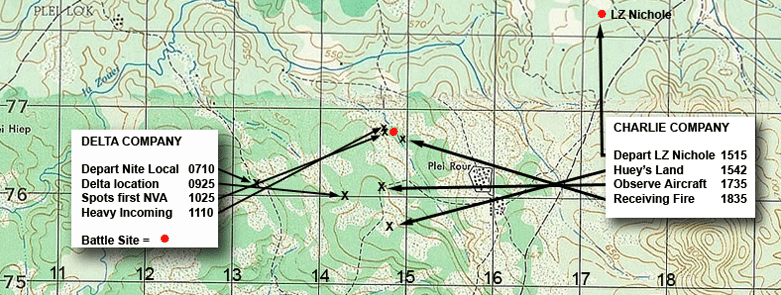
| 1735 | Charlie Co reports their current position as ZA147761.They’re about 700 meters south of us. |
| 1715 | (another late entry) Cider 23 on station will have Spades in 20 minutes. |
Cider 23 (FAC) has refueled and is now back on station. Spades are another set of A1E Sky Raiders on their way.
| 1725 | Gambler 56 on station. |
This set of gun ships replaces Gambler 26 and begins their gun runs.
| 1736 | Cider 23 (the FAC) reports strikes going in at this time. |
This set of A1E Sky Raiders also puts their strike in on our west side.
| 1809 | First dust off bird in at this time |
This is actually the next dust off bird in to pick up wounded. Radio log does not report this, but it’s Bikini 15 again. The Pilot was able to nurse the chopper that was damaged earlier back to Kontum where he basically crash landed, got out and got into another chopper, loaded the guns, refueled and headed right back out to help us.
| 1810 | Reported we received 2 more B-40 rocket rounds and now have 4 more wounded out on a dust off. |
Even though dust off’s are coming in to pick up our wounded, they aren’t able to stay on the ground long enough to get a full load of 6 wounded on board because of the enormous amount of small arms and B-40 rocket fire we are receiving.
| 1818 | B-40 rockets came from the southeast and that the second dust off bird has gotten out. |
| 1830 | Bn. Reports that they are moving out the gun ships and will start putting in red leg |
| 1835 | Charlie Co. just took 1 B-40 rocket and small arms fire. |
Charlie Company Enters Battle Area and is Hit
At this point Charlie Company enters the battle site. LT Orndoff is Charlie Company CO. He's been charge for only nine days. After the KIA and wounded casualties from May 27, he finds himself commanding an under-strength unit. A third of the company, 40 men, are FNG's (new guys) and he's concerned about the inexperience of his men. Some squads only have 4 men.
From some 600 meters away, Charlie Company has been watching the Sky Raider aircraft strafe the battle area before moving close to Delta's position. Once on the move, they had to cross a small rice patty to reach the wood line which was probably less than 50 meters east of Delta's position. One person at a time crossed the mucky patty, and less than 2 dozen crossed before an explosion sent everyone to hit the dirt.
Witnesses from Charlie Company now add to the storyline.
Sgt Jim Daniels C Company |
"The first man went across, then the second. Within a minute the dozen ahead of me had made it across, and now it was my turn. My feet sank into the gray muck above my ankles, but I was nervously focused on getting across in a hurry, and in just seconds I was on the other side, but being in the open was definitely an uncomfortable feeling. I moved rapidly into the trees. Ahead of me, on my left, are 4 or 5 men slowly moving up the hill into the woods. To my right the other men were about 10 feet away. They too are moving forward. I glanced behind and saw about 5 more guys cross the paddy. Suddenly an explosion! Everyone is instantly on the ground; my mouth is pressed into the dirt. I turn back to see a Grunt in the middle of the paddy rising to his knees, he’s covered with mud.
He hurriedly scrambles to the banks of the rice paddy for tree line cover. He’s carrying the radio, the tale-tell antenna rising high over his back" Sgt. Jim Daniels, C Co. 2nd Platoon Squad Leader |
Butch Cooper - FO 4.42nd Artillery |
I was right about in the middle of the rice paddy when the machine gun opened up, I thought I was a goner, then when I did get up to the bank I was lying beside my LT when they started working that machine gun up the bank and I could see the bullets hitting the ground coming right to us. The bullets stopped just short of hitting the LT in the head. I remember that rice paddy to be about a mile across, but I guess from my point of view, it was. Butch Cooper - B Battery, 4/42nd Artillery- RTO & FO assigned to Charlie Co. |
Mike Gowan C Company |
"We crossed a small paddy. Once on the other side all hell broke. Three of us were behind a small mound of dirt. Next thing I knew, an old type grenade landed on the mound. It looked like an old German grenade, pineapple type. It didn't have much of a punch to it. We were told to fall back. As I started to crawl back I was hit and lost my weapon. I got back to the other side of the paddy and there were around three new guys, none had a weapon. Mike Gowan - 2nd Platoon, C Co |
| 1840 | Charlie Co. reports that they have found bunkers and will throw hand grenades to knock them out |
| 1847 | Charlie Co. has 5 WIA’s and Delta now has 12 WIA’s remaining in our perimeter and 8 KIA’s |
| 1909 | Charlie Co. is continuing their movement toward Delta’s location. |
While the volume of incoming fire at our location has greatly diminished and the enemy basically defeated at this point, I have no doubt that the fact that Charlie Co. was fighting their way northward toward our position certainly contributed to the NVA deciding to hasten their withdrawal from the battlefield.
We have been in a continuous fire fight with only a couple of short lulls now for over 8 ½ hours
| 1909 | C Company lead element closing with Delta at this time |
Because of Charlie Company's earlier battle on May 27, 33% of Charlie Company were FNG replacements. Sgt Jerry Rayala of Charlie Company recalls entering the Delta perimeter. Rayala had been in country less than one week.
Sgt Jerry Rayala C Company |
We plowed forward towards Delta's perimeter covering the last several meters on a dead run. When we broke into Delta’s perimeter we were greeted with handshakes and heartfelt relief. They warned us to take immediate cover because they were taking enemy fire from several directions. Within the perimeter my squad filled in gaps where needed. We were inside the perimeter only minutes when the firebase resumed pounding the area with artillery rounds, so close at times that dead fall hit our helmets. There was a pause in the NVA attacks but we remained on full alert. Soon I teamed up with a platoon member and we frantically started digging a foxhole big enough for the two of us to squeeze into. Sgt. Jerry Rayala, C Company, 1st Platoon, Squad Leader |
Charlie Company is split in two at this point. The lead element, which had crossed the rice paddy, entered Delta's perimeter from the SE. However, the main element of Charlie company remains on the original side of the rice paddy and begins to maneuver back and around to enter Delta's perimeter from another direction. It takes an hour and 25 minutes to do so, entering the perimeter from the south.
| 1915 | Cider 22 left station at this time. (It's getting too dark to be effective) |
| 1958 | Bn. Commander informs Bde. That they are not going to try to get the WIA’s out now. They are receiving auto weapons from the dinks. |
Radio logs do not report this, but Bikini 15 ( right after dusk dark) reports by radio directly to me that he’s going to attempt one more sortie. He has 3 Delta soldiers and some more ammo on board and will try to get some more of our wounded out. This was an unauthorized flight, but the 3 Delta guys were doing everything they could to get out to the rest of us to join in the fight and Bikini 15 was determined that he was going to do everything in his power to do anything he could to help us.
Just as the bird was on short final (about 50 feet off the ground) the NVA opened up with a machine gun from the east side and across our perimeter to our west side where the chopper was attempting to land. The tracer rounds went right through the open doors of the chopper without hitting anyone on board or hitting the chopper. Bikini 15 had to abort the landing and peeled off to the west and returned to Kontum.
Right after first light the next morning he again contacted me directly on our company internal push (frequency) (another unauthorized flight) to see what he could do to help us.
| 2125 | Charlie Company has closed his location at this time. Will complete setting up of defensive perimeter |
The remainder of Charlie Co. is reporting that they have closed on our position and are setting up in defensive positions with us .We continued to receive occasional sporadic small arms fire during the night. At 2230 hrs the battle has now been ongoing for about 13 hours. We continued to fire interdictory artillery rounds on all sides of our perimeter all night long.
| 2300* | bde notes estimated reinforced NVA Company was engaged by 43 with an estimated 60-70 enemy KIA |
Radio logs report that Brigade informs Battalion that they estimated that we were engaged with a reinforced NVA Company and that the NVA had an estimated 60 to 70 KIA’s.
*This is incorrect
We were actually in a battle with the majority of the 24th NVA regiment.
Aftermath
After Delta Co. was extracted the next day, Charlie Co. remained in the area and conducted search and destroy sweeps. Over the next few days they discovered and destroyed (with the help of Rome plows) over 300 well fortified bunkers spread out over about a 500 meter surrounding area. Several hundred meters down a northern trail they found one NVA grave.
The math is not hard to do. They, like us, normally had 3 to 4 men per bunker. We had 93 men at the beginning of the battle. They outnumber us by more than 10 to 1.
My memory is that Artillery fired over 2200 rounds during this battle. I think that they had 3 different batteries firing, plus 4.2 mortars and our own 80mm mortars that participated in fire missions.
My count could be wrong, but we had 8 (possibly 9) different missions from gun ships, 3 flights of F-4 Phantom air strikes, 2 flights of A1E Sky Raider air strikes, 5 dust offs (2 of which failed and 2 that were only partially successful). 2 reported re-supply birds (this is actually inaccurate because there were 2 or 3 that kicked out ammo, plus every dust off that came in also brought ammo.
Radio logs report that Charlie Co. sustained 5 WIA’s and one KIA. The KIA was one of their medics, Paul Tilleman, assigned to HHC. He had gotten lost during the evening and was killed by friendly artillery fire. He was found on June 6 about 75 meters west of the perimeter.
Radio logs and other records report that Delta Company sustained anywhere from 32 to 37 WIA’s and 10 to 12 KIA’s
This is incorrect: Delta Co. sustained 8 KIA’s on June 5th plus one soldier who died on June 6 from wounds inflicted the day before. A medic from HHC, and assigned to Delta, also died. Delta had a total of 10 KIA. Charlie Company also had1 KIA, also a medic. The battle claimed 11 American lives.
JUNE 5 CASUALTIES
| Sgt. Louie Daily | (incorrectly reported as killed by small arms fire. He actually died later from wounds by shrapnel from an 82mm mortar received while helping load wounded on Bikini15.) | 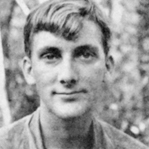 |
| Sp4 Laurence Paulsen | (killed by small arms fire when the fire fight initially began.) | 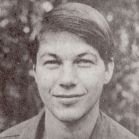 |
| Sp4 Alexander Santiago | (wounded initially by small arms at the beginning of the fire fight and again later by shrapnel from an 82mm mortar. He died from the shrapnel wounds.) | 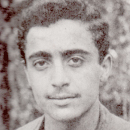 |
| PFC Fredric Henry | (killed by small arms fire.) | 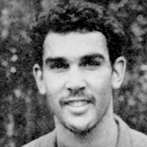 |
| PFC Mack Preston | (died from shrapnel wounds.) | 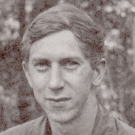 |
| PFC David Howard | (died from shrapnel wounds.) | 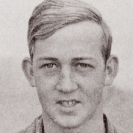 |
| PFC Thomas Horal | (died from shrapnel wounds.) | 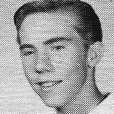 |
| PFC Thomas Williams | (died from shrapnel wounds.) |  |
| PFC Claudie Medcalf | (Medic from HHC assigned to Delta Co.) - (died from small arms fire.) |  |
| PFC Frederic Allmeyer | (died on June 6th from shrapnel wounds received on June 5th.) | 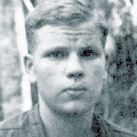 |
| PFC Paul Tilleman | (Medic from HHC assigned to Charlie Co.) It's been reported that he became lost in the dark while leaving the perimeter to retrieve his weapon. He was KIA by friendly artillery fire. HIs body was found the next day east of the Delta perimeter by members of 2nd platoon, Charlie Company. |  |
We had a total of 10 killed and 22 wounded. The battle itself claimed 11 lives, counting the medic from Charlie Company. One report recorded our wounded at 32. This incorrect number possibly came from a total number of casualties. 10 killed and 22 wounded. Another report recorded our number of wounded at 37. This was probably a mix up with the number of WIA’s sustained by Charlie Co. on May 27th.
Regardless where the incorrect numbers came from, the correct number of casualties for Delta Company as a result of the battle of June 5th is a total of 10 killed in action and 22 wounded. Charlie Company 5 wounded, 1 KIA)
PERSONAL REFLECTIONS
As you can see, there are no names or descriptions of individual actions mentioned in this report. This is on purpose. There were just too many acts of heroism by so many on that day, that to try to recount them all in this report would be impossible. We had men who advanced on the enemy without hesitation while under intense fire, and later continued fighting and maintained their position that was closer to the NVA than to our own men. Men who crawled out in the open, under heavy fire, to retrieve ammo kicked out of choppers. Some put their own life in peril while going out and pulling wounded comrades back into the perimeter. Many who continued to expose themselves to an enormous volume of enemy fire while helping to load wounded onto the dust off’s and others while changing their positions to reinforce other positions that became vulnerable when the NVA began counter attacking in different locations. Machine gunners who fired so many rounds that the barrels got so hot they couldn’t touch them without getting severely burned. Others who continued to fight, maintaining their position even when they found themselves alone and could not see any able bodied fellow soldiers to either their left or right. Many that were seriously wounded, but continued to fight all day and on into the night. Some wounded who refused to be med evaced so that they could remain with their fellow soldiers to continue the fight.
The soldiers of Delta Company were assigned the task of searching out and destroying the enemy. These men took the fight to a highly trained, disciplined and battle hardened enemy and against unbelievably overwhelming odds defeated them. The multiple acts of extraordinary bravery and heroism shown by these men on this day are unparalleled. I am proud to have had the privilege to serve with such men.
1st Lt. Larry Boyd
Delta Company Commander - 1969
Written fall of 2011
![]()
EXTRA's
PERSONAL RECOLLECTIONS BY THOSE WHO WERE THERE
The Following are recollections of the battle by men of both Charlie and Delta Companys'.
SP4 Mike Cresap, 1st squad, 2nd Platoon Delta Company
Delta normally humped in the mountains around Plei Trap Valley and Kontum, but on 6-5-69 we were in the lowland area of trees, shrubs and bamboo SW of LZ Nichole. Mid-morning I was in the 2nd squad from point when the first shots rang out to our front. Casualties were minimal at first, but increased as the amount of fire escalated over a period of time. At one point, the tremendous roar of firepower was so loud that it stuns and numbs you to the point one can hardly physically react or mentally think. You just want to crawl under your steel pot. A mortar round landed within our squad area causing multiple KIA and WIA. A defining life’s moment for me happened when although wounded, but not as seriously as others, I saw movement to my front and realized no one around me was firing, probably because they were all casualties. I picked up my M-16, but it was inoperable because of shrapnel damage. Same for the M-60 next to me. I had finally mustered up enough courage to fight for my life and I had no weapon to fight with. I threw two grenades to my front, not classic style, but hard low line drives thrown from the prone position to a specific area because I worried about one hitting a tree and bouncing back and blowing myself up. The prone position because anyone who stood up was immediately KIA. That’s what happened to our medics. I then picked-up a KIA’s M-16 and proceeded to fire on full automatic in a Z formation repeatedly. The M-16 got hot, so I picked up another M-16 and fired the same Z formation on semi-automatic. I could not hear or see anyone on my left or right firing. Then, to my left I heard and then saw a M-60 machine gunner going to work. A real morale booster for me. After some time, the firing stopped to my front and shifted to my right. That was another morale booster, although I knew someone else was catching fire. Degrees of firing went on all day. Later, the real concern was shrapnel from friendly fire landing so close. At dusk, the good men of Charlie Co. hooked up with us and saved the day. A nice, friendly E-5 from Charlie changed the bandage on my hand and I gave him a 7-up. My thanks to the men of Delta and Charlie. Everyday since 6-5-69 has been a good day for me.
****
Sgt Jim Daniels, 1st squad, 2nd Platoon Charlie Company (his first day in the field)
Word comes out to move out to the left and get the hell out of there. The wounded have been patched up enough to move. Gus, the man ahead of me, moves out, I’m right behind him. It looks like we’re leading the way. Moving up a slight slope we run into heavy elephant grass that’s about five feet high and the safer cover of trees is left behind. Word is passed up that Delta Company can hear us. American soldiers were never known for moving quietly. Running through my mind though, is that the Delta troops may be so jittery that they might accidentally shoot us as we near their position.
“Over here,” a voice calls from straight-ahead. The grass gives way to an open clearing. About 30 feet away are the men of Delta. They’re hiding behind little hills of freshly dug dirt, logs, anything that would protect them. There are rucksacks scattered everywhere, canteens, and helmets, all thrown down on the spot. Men are digging holes with their steel pots, sticks, anything available.. I found myself next to kid (Mike Cresap) who says with deep meaning, “Boy, are we glad to see you.” To which I reply, with equal meaning in my voice, “Boy, am I glad to see you.” He’s wounded in the arm; a blood soaked bandage around the wound. I’ve got clean bandages and offered to put on a new one. He says OK, and I begin to change the dressing. I asked if anyone has been killed. I don’t recall him saying anything, but he points to a covered body just six feet away, legs and arms hanging out from under a blood stained poncho.
****
Sgt Del Bibles , 1st Squad, 1st Platoon Delta Company
|
On 5 June the company had already stopped several times that morning, each time we set up a defensive position for our rear flank. Since we were used to performing SRPs, our guys knew that whenever we stopped, set up defense first and be alert, There were no grumbles or complaints from the squad, all knew the situation we were in. When the point element reported a contact we immediately put our squads in a defensive posture, moving forward when we had to, but concentrating on looking and listening for the enemy at our rear. This had become the normal routine all morning but now everyone was even on more of a heighten alert, if this was even possible. All of this anxiety was before shots had been fired. Sometime, after firing commenced, Sgt. Louie Daily was either called or went up to the CP area to help. During the firefight, my world was with 1-1 and keeping contact/support to the 2 squads on either side of us. We were probed many times; it appeared that the NVA were trying to flank us, looking for a weakness. At different times in the firefight, there were short lulls, followed by intense fire, to incoming, to sniper fire. |
During the entire day, I did not see anyone panic, everyone was doing their job, and no one gave in to any fear. As the firefight progressed, I re-positioned my squad into 2 man teams to more adequately protect our flank, each other, and tie in with squads on either side of us. This was to make sure that our rear perimeter was secure with interlocking fire. Sgt. Earl Albertson (1-3) was also re-positioning his squad. The discipline of the 1st and 3rd platoons, to concentrate on their areas was extreme, because of the heavy fire being to the company’s front at the beginning of the firefight. This paid off when the NVA tried to flank us and our perimeter was secure.
Walter Runningcrane ,our 60s gunner, was wounded and later when time and circumstances allowed everyone in the squad (and others) at one time or another spent the night looking after him, talking to him, making sure that he didn't’t go into shock, until he was finally medivaced out .
I believe that our success that day was not only the result of the bravely of our guys engaging the enemy and their professionalism, but a great deal was because of other factors. The RTOs that kept communications open, helped with the wounded, redistributing ammo, assisting whenever possible really helped morale. Bikini 15—wow!!
Without great leadership, I believe that the day would have turned out differently. Calling in air strike after air strike, using artillery effectively all around our perimeter, managing the battlefield, giving us the support we needed without wavering. This was the essential element in our overcoming a superior number of the enemy. This, from beginning to end, was a cohesive unit, all fighting for the common cause.
Del Bibles reflects about Louie Dalie
The sacrifice that Louie Dalie made… for his fellow soldiers. I feel that it is important to not just tell the story of those that survived 5 June, but those that did not. I can’t tell all of Louie’s story, just a small part.
Louie Dalie was “short”,(as in time left in country) but the fact that he had less than 3 weeks (17 days) left in country did not cause him to cease doing his job. In my opinion, he did the opposite. Louie volunteered to be my RTO on those last few marches. You and I both know, that in contact, the enemy targets RTOs, officers, M60 gunners and squad-leaders whenever possible. He knew that being a RTO was one of the most dangerous assignments that one could volunteer for when contact was eminent, the radio antenna was like a bulls eye for the enemy. We also knew that once we were engaged in a firefight, incoming would be directed at the CP. If the enemy could knock out our communications, they had a chance to inflict heavy causalities.
Immediately after we heard on the radio that our point element spotted an individual, Lou and I immediately assumed that it was NVA until we heard differently. The word was quickly passed to all in 1-1. During the short lull between the first radio transmission and when contact was initiated, Earl Albertson(1-3), one of the best squad leaders that I have ever met, Lou and I briefly discussed the situation. Depending on the situation, if the company had to fall back, they would probably fall back to us. If the company advanced, we would have to be prepared to move forward and cover our rear. This is in no way being detrimental to our officers or senior NCO’s. We realized that in recent weeks, in other units, the casualty rate of officers tended to be high and their life expectancy tended to be short. In reality, all of our platoon leaders were wounded, but not incapacitated.
Remember, all 3 of us had been in country for approximately 11 plus months and all three of us had experienced enemy contact as members and squad-leaders in both SRP’s and with the company. To be honest, every single squad in D Company had above average squad leaders and even better soldiers.
Lou made his way to the CP under heavy small arms fire. I believe that he spoke to 1-3 before going to the CP. Later, the CP would be under heavy incoming mortar fire targeting our officers and our RTOs. Everyone knew that whenever a chopper lands, mortar fire, B40 rocket fire and small arms fire would be extremely intense, directed at the LZ. Without regard for his safety, Lou, Chopper Black and others kept communications open and then assisted in loading the wounded on Bikini 15. Louie was mortally wounded by incoming fire… hit by shrapnel, receiving multiple wounds. During one of the lulls Lt Boyd talked to him, offering him encouragement. He was seriously wounded, but remained alert. Matter of fact, he was smoking a cigarette with assistance from one of the guys that was helping take care of him. We just couldn't get a chopper in to get him out. During all of this time, he never complained. To the best of my knowledge, he remained that way until the end.”
Lt. Simpson, 1st Platoon leader was constantly moving between the CP and 1st Platoon. This was during the time, that to move meant to crawl, to stand meant death. On one of his trips, just as Lt. Simpson was leaving the CP, he spotted a sniper in a tree drawing down on Lt. Boyd. With his last round, he killed the sniper. If he had missed, our only 2 officer would probably have been killed. Immediately, our M60 gunners fired suppressing fires in the trees, just in case.
Sgt Bob Sams, 2nd Platoon, pinpointed the position of the mortar that had been firing at us. He managed to crawl to the CP, even though he was wounded in his legs to give the location so the LT could direct fire. That action saved many casualties.
One of the choppers that brought in a re supply of ammo and dropped it to us at low altitude and full speed. Boxes of ammo came flying through the air, bouncing through the perimeter. One of my 1-1 guys jumped up as if to catch a 50 pound box going about 90 mph (Remember, we were still getting incoming small arms fire at the time). With everyone yelling, he finally thought better of it and jumped out of the way. Men from 1st platoon retrieved most of the ammo that fell outside the perimeter.
These are just some of the men and actions that I personality know about. There were many others that did fantastic feats that day such as Sgt. Tony Harperand and Sgt. Mike Widrig, (2nd platoon Leader) who were part of the element pulling point that first spotted and engaged the enemy.. But, let me stress, there were many others, too many, to accurately list in 2nd platoon, 3rd platoon, 1stplatoon, and my squad (1-1) that went above and beyond the call of duty to ensure that we overcame the odds stacked against us.
No one slacked that day, not 2nd platoon, who bore the brunt of the first contact, not 3rd platoon, not 1st platoon, not our officers, and especially not those that made the ultimate sacrifice.
Time frame from 1-1 point of view - Approximate times
0541 5 June Sunrise
0600 1-1 LP replaced with OP
0630 Squad-leader briefing (I don’t remember if this was by Lt Boyd or Lt Simpson, but believe it was Lt Simpson) We were told that 1st platoon was last in line of march and 1-1 was rear security.
0630-0700 1-1 Squad briefed, everyone knew their duties. These guys had it together. I felt totally secure being with everyone in the squad.
0700 OP pulled in
0710 SP our night location
0735 Bunker Complex about 500 meters from our night location. We set up rear security, as the rest of the company examined the complex.
0810 We were the last unit to cross the complex as the company moved out. Spirits and morale high, but tense.
0810-1000 Slow careful march-stopped several times- Established rear security each time. During the march, 1-1 squad-members were rotated several times. This was to give relief to the man walking drag and constantly watching the rear. Every other man was watching either left or right. The squad made it easy, they knew what to do and how to set up.
1010 First sighting and the squad was quickly briefed. Squad again went into defensive position. Louie, Earl (1-3), and I also quickly conferred (see above).
1020-1100 The company moved forward to tie in with the point element. 1-1 moved forward, constantly covering our rear and set up a defensive position at the rear most position of the company’s perimeter.
By the way, I really appreciated C Company coming in.
***
![]()
WEBMASTER NOTE: If you were a part of this battle and would like to share our memories of this day, please email them to us for possible inclusion into this report. Email information to: DELTA BATTLE
Stars and Stripes Article, July 25, 1969
Click HERE to see Larger Size PDF of this article
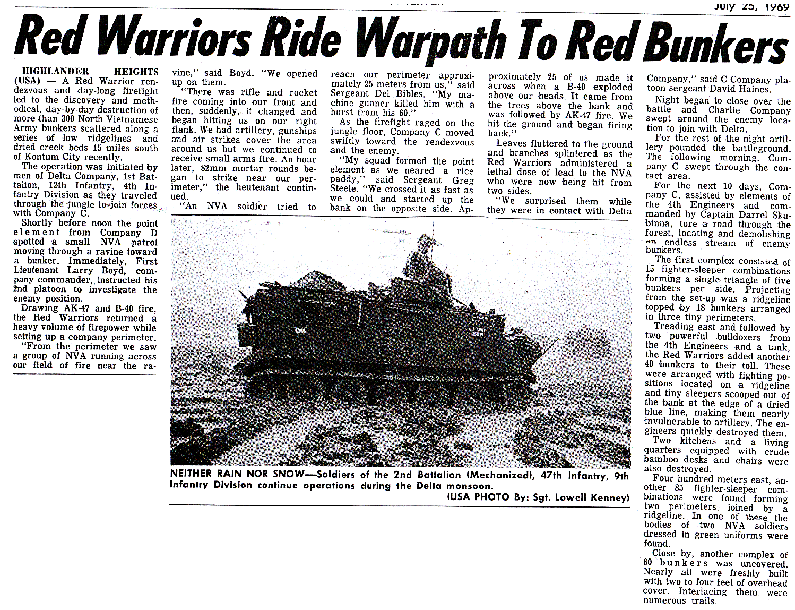

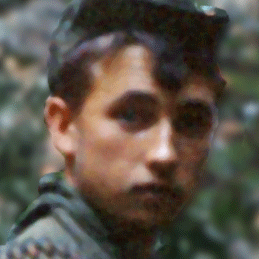

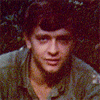




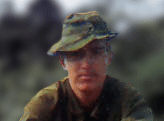 Sgt. Del Bibles - 1st Squad, 1st Platoon
Sgt. Del Bibles - 1st Squad, 1st Platoon